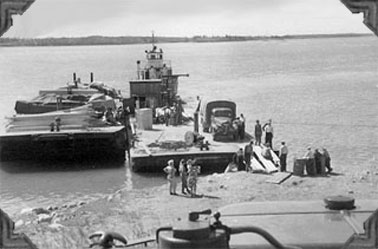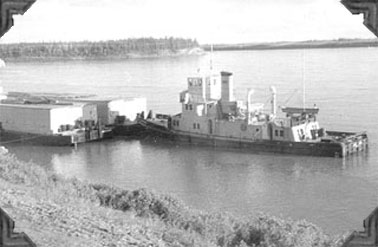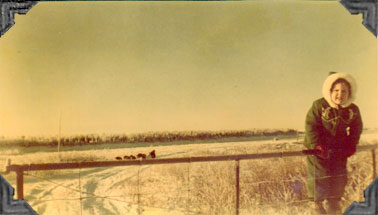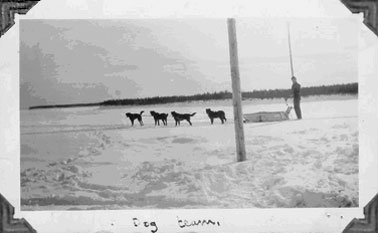Page4: Ft. Providence (continued)

Tugboats
and barges bringing in supplies
Yearly Rations
All the bulkier supplies, including food, oil for heating, gas and
oil for the truck and the engines, and most of the bits and pieces
necessary for maintaining the equipment, arrived in the summer. These
vitally important items were transported on barges pushed by tugs
down the Mackenzie from Hay River. Goods first had to traverse a portage
to Hay River from Fort McMurray, the terminus of the railway system
on which everything had begun its journey from the South.
It was, of course,
imperative to ration these supplies to make them last over the whole
year, which objective sometimes needed some ingenuity to accomplish.
Each man was entitled to a year's supply of rations, for which $37.50
per month was deducted from his pay. The same amount was also deducted
as rent for our PMQ. An extra man's ration share could be ordered
for each "dependant," as wives and children of soldiers
were termed. We chose instead to arrange for a little variety in the
menu by ordering a year's supplies from Western Grocers, a wholesale
firm in Edmonton. Very careful ordering was essential and taking everyone's
preferences into consideration was a must. On returning to southern
life I found that buying groceries once a week seemed an unnecessary
and incredibly fussy way of doing things!
Meat came either
in cans or as frozen carcasses, which were hung in the refrigerator
unit and were jointed and shared out by the station cook. Milk was
powdered or canned, and fruit and vegetables came dried or in cans
or bottles. It took a very long time indeed to get the children to
eat fresh fruit and salads when we finally returned to southern Canada,
as they were so used to canned and frozen food. The concept of fresh
food was almost completely alien to them, although we did manage to
grow a few lettuces and did occasionally get some fresh fruit in by
air.
One could also
obtain sacks of potatoes and eggs, a crate at a time, but I cannot
remember how these were obtained or where they came from. I think
that the suppliers were fairly local and sent these items in by local
plane or boat. Bread, cakes, cookies, etc. were made from the flour
and baking supplies provided in the rations. I soon got used to baking
bread twice a week.

The Pelican Rapids, the Hudson's Bay Company
supply boat.
When the river
became free of ice in June, the boats that had been laid up for the
winter were able to run again and resume bringing in supplies. Before
then, if one had been unable to make the year's rations stretch over
the winter, it was sometimes possible - at very high northern rates
- to buy the missing items from the Hudson's Bay post or from the
one local native trading post. But the added cost of importing supplies
to the North made this a very expensive proposition. Any supplies
that were desperately needed could be sent by air (and received if
weather and landing conditions were favourable), but again this was
a very expensive procedure.
Since I had experienced food rationing in England during the war,
this way of life posed no problems for me and I never ran out of supplies.
It did take me some time, though, to understand the warning from Jorgy
not to give the station cook any vanilla essence if he tried to borrow
some after running out of his yearly supply. To my surprise, I discovered
that this alcohol-based flavouring essence was regarded as a standard
alcoholic drink. I remember one Easter the "boys" expressing
their hearty thanks when I sent over some hot cross buns. They said
they particularly enjoyed the vanilla icing!
Dealing with
Diapers
One of the several challenges to be faced was baby laundry, and perhaps
only the parents of babies are able to appreciate the ramifications
involved. This was, of course, before disposable diapers. Things have
changed so much since those days that I feel an explanation of baby
care then is necessary for a modern audience. Diapers were in those
days made from cotton cloth cut and hemmed into a shape that was almost,
but not quite square. One folded the diaper into a shape suitable
for either a boy or a girl (the thick side either fore or aft), and
then pinned it with two large diaper safety pins, one to each side,
to the baby's little undershirt.
A recent improvement
had made available paper diaper-liners, which, even if expensive,
did save some of the labour involved. They could be discarded after
being soiled, leaving the diaper only slightly dirty. These liners
also washed quite well if one accidentally included them in the laundry!
Used cloth diapers
were rinsed in the toilet and then placed in a covered diaper pail
filled with water to which a little disinfectant had been added. At
the end of twenty-four hours, there would be about a dozen soiled
diapers in the pail, and each day these had to be washed.
If one's baby
developed diaper rash or if the diapers began to lose their pristine
whiteness, one had to boil them on the stove in a large container
of soapy water, rinse them in fresh water, and then dry them on the
clothesline outside (if the weather was warm enough). The washing
process of course necessitated a supply of water and a means of heating
it, which, although a matter of course for those living "outside,"
was not quite so easy in the North.
In the winter,
it was wonderful having a large basement in which to suspend clotheslines.
Here I could hang the washing to dry after it had been washed, rinsed,
and put through the wringers of the washing machine. This practice
was common in many houses, including army PMQs, in other parts of
Canada.
I developed a
great respect for the Slavey mothers, whose babies were always spotlessly
clothed, even if the older children were a little on the grubby side.
Their clotheslines, like mine, always bore a long line of diapers!
And of course, subsequently, training pants! Those mothers were seldom
lucky enough to have husbands who carried water or ice from the river
for them, as mine did for me when it was impossible to pump water
from the river. Their husbands were usually away on their trap lines
in the winter and perhaps too busy fishing in the summer.
Native Inhabitants
The medical authorities in the south had warned us not to let our
children play with the native children because of the prevalence of
tuberculosis in the North. This was a terrible scourge among native
families; sufferers were obliged to spend months and even years away
from home in special TB hospitals. Consequently, when one had small
children, it was impossible to do more than just pass the time of
day with any of the natives. I was never able to know any of them
well.
The Slavey women
were adept at making wonderful moccasins, mukluks, mitts, parkas with
fur-trimmed hoods, and other articles out of the tanned skins of various
wild animals. They embroidered the articles beautifully, using designs
apparently based on the wild roses that grew everywhere and whose
fragrance in the long, warm days of summer permeated the air.
They were especially
expert in moose-hair tufting, a craft that I believe is unique to
Fort Providence. The moose hair was stitched in tufts to the material
to be ornamented and then trimmed to produce a very pretty mossy effect.
These craftswomen were so skilled that, if you put in an order for
moccasins or mukluks, they needed only one swift glance to estimate
the size of your feet.
I once made an
embroidered flannelette baby jacket for an expectant mother. She responded
later, when I was expecting my second child, with an exquisite pair
of baby moccasins in bleached caribou skin trimmed with white rabbit
fur and embroidered beautifully with a charming moose-hair tufted
pattern. The moose hair was dyed in the traditional pink and green,
which colours made the rose design a very convenient one. Alas, my
family all have enormous feet and the little moccasins were too small
even for the newborn baby. On the other hand, this enabled me to keep
them as a precious souvenir for years!
The Slavey men
were all expert trappers, hunters, and fishers. In the summer they
would catch large quantities of fish in the river. The fish would
then be dried and smoked on wooden racks set up either in front of
their cabins or on the river edge. These fish would be used in the
winter to feed the dog teams.
Having previously
only read about the Native way of life in tales of adventure, I expected
to find these North American Indians paddling the canoes from which
they fished. It was a big surprise to find that although they did
use paddles, their main means of locomotion for a canoe was a small
outboard motor, or "kicker"!

Jill on front gate, with dog team passing
along the road
Dog Teams
A familiar sound throughout the year was the melodious howling of
the sled dogs. When not hitched up a sled, the dogs were chained each
to its own doghouse outside the Native dwellings. From these doghouses
the chorus of howls travelled through the village from team to team,
to be finally taken up by wolves outside the settlement. At night
it was a wonderful, eerie, northern sound.

Dog team with sled and driver
At times the "boys"
at the station would run a dog team or two. Inexpert drivers sometimes
confused the commands for right and left. When the team turned sharply
from the compound gate to the main road, the driver would be leaning
the wrong way, and was completely unbalanced. He would end up in the
snow with the sled on its side, its load upset and the dogs all excited
and tangled up in their traces. This was not much fun, except for
the spectators, especially when the load was the station garbage on
its way to the dump!
All the dogs
loved to run, and the drivers' long whips seemed to be used only for
cracking on either side of the team to encourage them and occasionally
flicking the ear of a misbehaving animal. To encourage the dogs to
run faster, drivers made a soft trilling noise like the Scottish rolled
R.

Constables Norm Hambley and Tommy Scott,
RCMP,
and Jill. Note the lettuces growing in the background.
One of our two
RCMP constables, Tommy Scott, a novice in the North and on his first
patrol with the dogs, had a difficult time controlling his team at
first. It was the start of winter, but all the water in the creeks
was not yet frozen. The excited team kept tipping the sled over in
water, getting all tangled up in their traces and fighting with each
other. The poor man had to take his mitts off to untangle the traces,
his hands began to freeze, he could no longer feel what his fingers
were doing, the dogs were still fighting, and he was at a loss as
to what to do next. Then, in desperation, he had an incredibly bright
idea: he bit the ear of the lead dog! It worked instantaneously -
he was now the master of the team. The lead dog quieted down and behaved
himself from then on.
Tommy was a little
tougher with the team from then on and did not let them get so out
of hand. He had left Scotland only eighteen months before and thought
of dogs as pets rather than working animals. (Another memory of Tommy
is of him trying to teach my children to say "Och aye!"
instead of "yes" and "Och noo!" instead of "no."
It never actually caught on, in spite of his best endeavours.)
The RCMP dogs
were particularly tough, as they were part wolf and bigger and heavier
than the malamutes used by most families. When Dick was introduced
to them in their fenced enclosure at the Mountie compound, one dog
stood on its hind legs and put its forepaws on Dick's shoulders, its
jaws wide open, panting hotly into his face. Dick in those days was
six feet, two inches! It was quite a terrifying experience and he
was considerably relieved when Constable Norm Hambley assured him
that the dog hadn't seen too many people lately and was just making
friends!
[Next
Page]
Pages: [1]
[2] [3]
[4] [5] [6]
[7] [8]
[9] [10]
[11] [12]
[13] [14]
[15] [16]
Return to top of
page
Return to the Watts
Family page